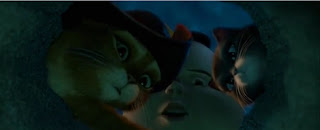Puss in Boots
This movie is very much interesting and pack with moral lessons.
It is a cheerfully chaotic jumble of fairy tale and nursery rhyme characters parachuted into a Spanish storybook setting. It also looks terrific: brighter, with a lot more visual pizzazz. Even when the story loses its thread, the movie rewards your eye.
The tale, revolving around Puss, a popular character first introduced in“Shrek 2,” imagines this vain, spoiled, swashbuckler (voiced by Antonio Banderas) with delusions of grandeur, colliding with Humpty Dumpty, the Goose That Laid the Golden Eggs, Jack and Jill, and Mother Goose herself. Puss is given a tentative romantic interest in the feisty and seductive Kitty Softpaws (Salma Hayek), who first appears in disguise and eventually becomes his sidekick and partner in crime. Kitty’s tragedy is that she has been declawed, but the movie makes little of it. Despite some perky quasi-flamenco dance numbers, their teamwork never quite soars into Astaire-Rogers heaven.
Visually, at least, most of the other transplants from children’s stories are indelible. The avaricious Jack and Jill, voiced by Billy Bob Thornton and Amy Sedaris, are villainous twangy-voiced old folks who roar around the plains in a covered wagon making trouble. Mother Goose, silent except for her fog-horn honk, is an ominous Godzilla-size bird who swoops down from on high to protect her golden child whom the outlaw partners have stolen from above.
Puss has his charms, but he is not as memorable a character as Shrek or Shrek’s mouthy sidekick, Donkey. Consequently the story, which involves a quest for magic beans and golden eggs, feels improvised and diffuse. The most sharply drawn character, Humpty Dumpty (voiced by Zach Galifianakis), Puss’s erstwhile best friend turned enemy, is also the most complex. Jealous and treacherous, but with a seed of good, he is an animated Rorschach test whose remarkably expressive features register more shades of ambiguity than I can recall encountering in a Hollywood animated character. There are many, many egg jokes.
Puss and Humpty Dumpty first meet at an orphanage, where they hatch a dream of acquiring magic beans to grow a beanstalk that they intend to climb into the clouds to steal the Goose That Lays Golden Eggs. But the two are separated before they can realize their plan, and Puss becomes an outlaw. When they meet again, Humpty Dumpty is fuming that Puss betrayed him, but they reteam anyway for an adventure that involves some spectacular midair derring-do.
“Puss in Boots” was directed by Chris Miller from a screenplay by Tom Wheeler, who wrote the story with Brian Lynch and Will Davies. Early in the film you have the sense that this picaresque adventure tale had only the sketchiest of master plans. It is too complex and has too many changes of heart to be a smooth, coherent ride. Puss isn’t as clear-cut a personality as he was in the “Shrek” movies. The moral of the story — something about revenge and forgiveness — simply has little resonance.
Visually, however, there is much to admire. The movie’s most remarkable feature is a spectacular use of 3-D that raises the bar for a mainstream animated film. Avoiding the usual stereoscopic clichés, “Puss in Boots” often looks multidimensional, especially its action sequences.
And unlike the “Shrek” movies “Puss in Boots” doesn’t give you the slightly queasy feeling of being stranded at a Friars Club roast where the talk is peppered with inside show business jokes. The tone of the screenplay is more innocent, and the movie is apparently directed at a slightly younger audience. That’s all to the good.
“Puss in Boots” is rated PG (Parental guidance suggested). Some adventure action and mild rude humor.

























































































































































































































No comments:
Post a Comment
Thank you for your comment!